Thalassiodracon
Thalassiodracon (tha-LAS-ee-o-DRAY-kon) is an extinct genus of plesiosauroid from the Pliosauridae that was alive during the Late Triassic-Early Jurassic (Rhaetian-Hettangian) and is known exclusively from the Lower Lias of England.[1] The type and only species, is Thalassiodracon (Plesiosaurus) hawkinsi (Owen, 1838).[2][3]
| Thalassiodracon Temporal range: | |
|---|---|
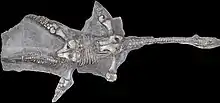 | |
| Lectotype specimen NHMUK 2018, found in the Lower Lias strata, Street, Somerset, England. | |
| Scientific classification | |
| Domain: | Eukaryota |
| Kingdom: | Animalia |
| Phylum: | Chordata |
| Class: | Reptilia |
| Superorder: | †Sauropterygia |
| Order: | †Plesiosauria |
| Family: | †Pliosauridae |
| Genus: | †Thalassiodracon Storrs & Taylor, 1996 |
| Species: | †T. hawkinsi |
| Binomial name | |
| †Thalassiodracon hawkinsi (Owen, 1838) | |
| Synonyms | |
| |
Discovery and naming
Thalassiodracon hawkinsi is known from a number of complete skeletons (lectotype: NHMUK 2018) acquired by the fossil collector Thomas Hawkins in Somerset, England during the early 1830s, before 1834. Hawkins, an eccentric Pre-Adamite who had his fossils heavily restaured and illustrated by distinguished artists in expensive editions to propagate his ideas, named these Plesiosaurus triotarsostinus in 1834 and Hezatarostinus in 1840 but these names are generally disregarded.[3][4][5] Thalassiodracon lived in the Late Triassic (Rhaetian) to the Early Jurassic (Hettangian) of Europe (age range: 201.6 to 196.5 million years ago).[3] It was named as Plesiosaurus Hawkinsii in 1838 by Richard Owen[2] and it was made the type species of the genus Thalassiodracon in 1996 by Storrs & Taylor.[1]
A replica of the holotype specimen, replica catalogued as LDUCZ-X227, has been in the collection of the Grant Museum of Zoology and Comparative Anatomy in London, England since 1890 after being catalogued by Ray Lankester, and it is a cast of a specimen created in 1862 by Henry Augustus Ward.[6] The original fossil, catalogued as NHMUK 2018 and also bought by Hawkins in the 1830s, can be seen on display at the Natural History Museum, also in London, England.
The genus name Thalassiodracon means "sea dragon", while the specific name hawkinsi honours Hawkins.
Description
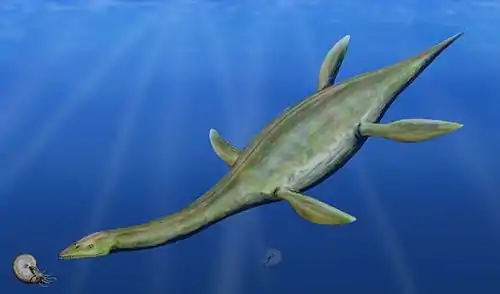
Thalassiodracon was a small plesiosaur, measuring approximately 1.5–2 m (4.9–6.6 ft) long and weighing 40 kg (88 lb).[7][8][9] It has a skull length of 17 cm (6.7 in), neck length of 75.5 cm (2 ft 5.7 in), and trunk length of 68 cm (2 ft 3 in).[10]
The neck of Thalassiodracon, however, was slightly shorter than that of subsequent Plesiosaurs.[6] The cervical vertebrae were between 27 and 31, while those of Plesiosaurus were 35 - 37. Moreover, the skull was unusually short and equipped with long teeth. The orbits were very large, with sclerotic rings. Like all plesiosaurs, this animal had legs like paddles for swimming in the sea.
A computed tomography of an exceptionally preserved skull, and examination of other specimens (Benson et al., 2011[11]) yields new anatomical data. Thalassiodracon had a dorsomedian ridge on the premaxilla, a squamosal bulb, four premaxillary teeth, and a heterodont maxillary dentition.[1][12]
Classification
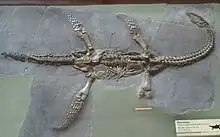
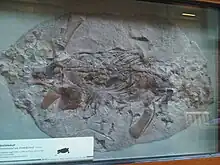
Thalassiodracon was originally placed in the genus Plesiosaurus. It has been classified in a new genus Thalassiodracon many years later following an examination of a skull. This animal is considered one of the oldest representatives of the group of plesiosaurs, perhaps ancestral to the superfamily of Pliosauroidea (short-necked plesiosaurs).[13]
The following cladogram follows an analysis by Ketchum & Benson, 2011.[11]
References
- Storrs, G. W & Taylor, M. A. (1996). Cranial anatomy of a new plesiosaur genus from the lowermost Lias (Rhaetian/Hettangian) of Street, Somerset, England. Jour. Vert. Paleo. 16:403-20.
- Owen, R. (1838). A description of Viscount Cole's specimen of Plesiosaurus macrocephalus (Conybeare). Proceedings of the Geological Society of London 2, 663-666.
- Paleobiology Database
- Hawkins, T. (1835). Memoirs of Icthyosaurii and Plesiosaurii.
- Hawkins, T. (1840). The Book of the Great Sea Dragons, Icthyosaurii and Plesiosaurii, Gedolim Taninim of Moses, Extinct Monsters of the Ancient Earth, With Thirty Plates copied from specimens in the authors collection of fossil organic remains, Deposited in the British Museum. William Pickering, London.
- Ward, Henry A. (1866). Catalogue of Casts and Fossils From the Principle Museums of Europe and America with Short Descriptions and Illustrations. Benton and Andrews. Rochester, N.Y.
- Smith, A.S. (March 18, 2008). "Plesiosaurs". Geology Today. 24 (2): 71–75. doi:10.1111/j.1365-2451.2008.00659.x.
- Paul, Gregory S. (2022). The Princeton Field Guide to Mesozoic Sea Reptiles. Princeton University Press. p. 97. ISBN 9780691193809.
- Roger B J. Benson; Mark Evans; Michael A. Taylor (2015). "The anatomy of Stratesaurus (Reptilia, Plesiosauria) from the lowermost Jurassic of Somerset, United Kingdom". Journal of Vertebrate Paleontology. 35 (4). e933739. doi:10.1080/02724634.2014.933739.
- Roger B. J. Benson; Mark Evans; Patrick S. Druckenmiller (2012). "High Diversity, Low Disparity and Small Body Size in Plesiosaurs (Reptilia, Sauropterygia) from the Triassic–Jurassic Boundary". PLOS ONE. 7 (3): e31838. Bibcode:2012PLoSO...731838B. doi:10.1371/journal.pone.0031838. PMC 3306369. PMID 22438869.
- Hilary F. Ketchum; Roger B. J. Benson (2011). "A new pliosaurid (Sauropterygia, Plesiosauria) from the Oxford Clay Formation (Middle Jurassic, Callovian) of England: evidence for a gracile, longirostrine grade of Early-Middle Jurassic pliosaurids". Special Papers in Palaeontology. 86: 109–129.
- Roger B. J. Benson, Karl T. Bates, Mark R. Johnson & Philip J. Withers Cranial anatomy of Thalassiodracon hawkinsii (Reptilia, Plesiosauria) from the Early Jurassic of Somerset, United Kingdom - Journal of Vertebrate Paleontology - Volume 31, Issue 3, 2011
- Plesiosauria
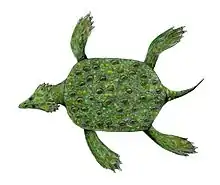
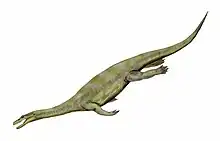


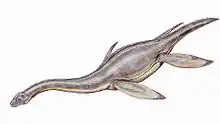
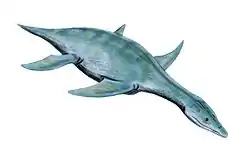
.png.webp)